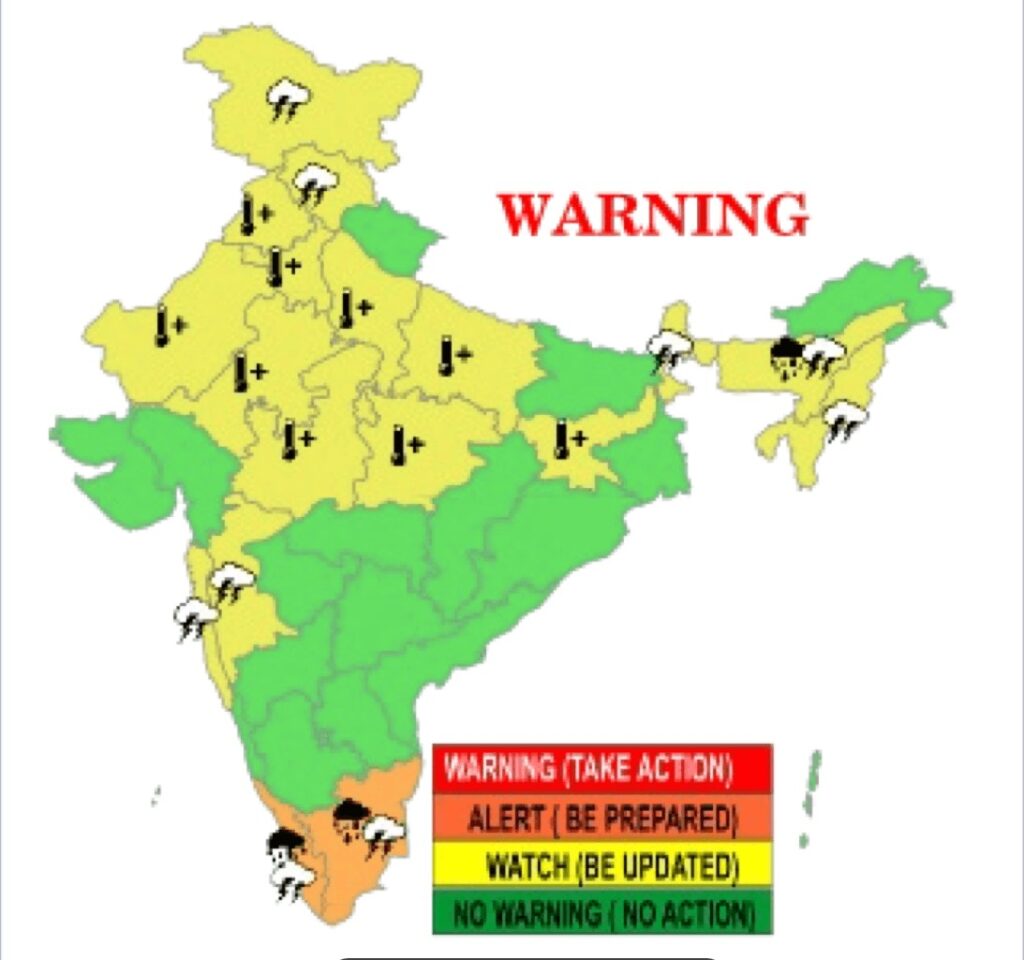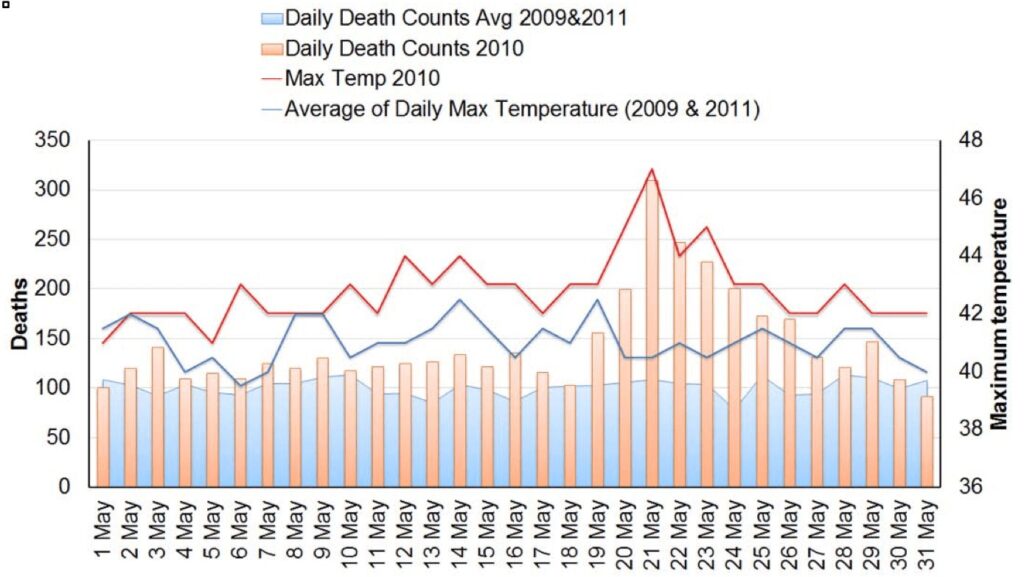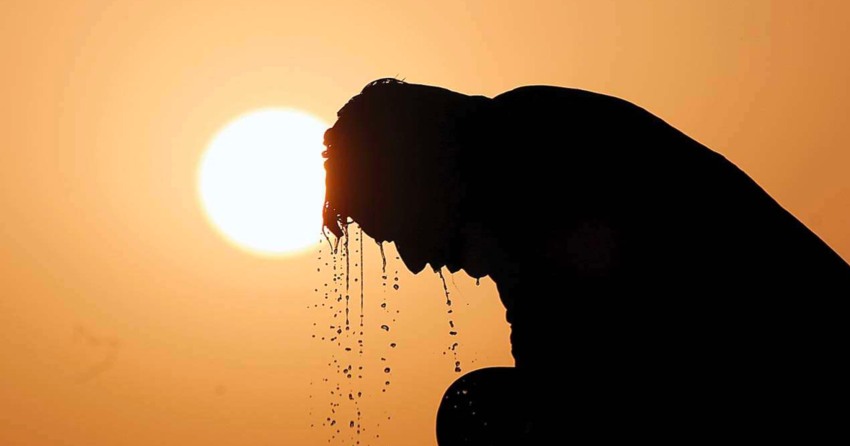In the peak of the summer of 2019, Bihar’s Gaya city was put under Section 144, a law typically invoked to control law and order situations, especially over the past two years, with lockdowns. But Gaya’s curfew was for an unusual reason—excessive heat. As temperatures in June 2019 soared to 45℃, killing 76 people in the state, Bihar’s administration prohibited gatherings of four or more people in an area. More restrictions followed—timings for outdoor work were changed, and schools temporarily shut down to prevent exposure to the heat wave.
A heat wave is said to set in a when the maximum temperature of a weather station reaches more than 45°C for at least 2 consecutive days; or if the departure from normal temperatures is 4.50℃ to 6.40℃. 2019’s heat wave which brought Gaya to a standstill was one of the longest and most intense heat waves that India had ever seen. But, just three years later, the summer of 2022 has broken another record.
March 2022 was the hottest March that India has witnessed in 122 years, with the Indian Meteorological Department (IMD) issuing several alerts for heat waves in various regions, including the likes of Jammu and Himachal Pradesh. Between 1992 to 2015, such heat waves have resulted in deaths oscillating between a reported 400 to 3000 per year.

But, there is a catch. “Actual numbers of deaths resulting from heat waves are higher than the reported numbers,” reads a National Disaster Management Authority (NDMA) document from 2019, a concern that has resurfaced in various government workshops and meetings since. This data gap becomes increasingly worrisome as the latest Intergovernmental Panel on Climate Change report suggests that India is heading towards intensified hot extremes. Why are heat-related illnesses and deaths under-reported, and what impact does this data gap have on preparing for this extreme weather event?
The Big Question Behind the Missing Data: How Do We Know It’s a Heat Stroke?
“India’s reported numbers of heat wave deaths is often just the tip of the iceberg,” explains Dr Dileep Mavalankar, Director at the Gandhinagar-based Indian Institute of Public Health. “About 10% of the actual heat-related deaths get reported as due to heat stroke, while about 90% are not visibly reported.” Most of these invisible deaths are those that are indirectly impacted by heat, which means that the victim gets exposed to the heat conditions despite staying indoors. Children, the elderly, and those with comorbidities often fall in this category.
“For doctors to diagnose heat strokes in patients, it is important to know whether a patient was working outdoors, in extreme heat for long hours, without adequate hydration, and started feeling unwell, apart from analysing their symptoms,” shares Dr Naseem A Hussain, senior consultant at Bengaluru-based Specialist Hospital. “In the case of deaths due to extreme heat, it is easier to diagnose when heatstrokes impact a group of people in the same region [who are all] showing similar symptoms or leading to deaths. For individual, sporadic mortality due to a heat stroke, it can be challenging to draw a correlation.”
Underreported data implies a reduced capability for analysing trends and releasing specific advisories. “For instance, we have seen that when days are hot but nights become cooler, the death rates due to heat are much lower, as opposed to times when both nights and days are hot. In such cases, even people inside their homes are susceptible to heat-related deaths,” says Mavalankar. He adds that heat waves at the beginning of the summer tend to cause more deaths than those later in the season, since people slowly get used to the heat and how to respond to it over the months. “If we have correct data of reported deaths, we will be able to communicate these trends strongly to the people and give nuanced advice depending upon the type of heat wave, its time, and duration of occurrence,” he adds.
To make it easier for doctors to attribute a fatality to the heat, the Ministry of Health released a National Action Plan on Heat Related Illnesses in 2021, which included guidelines for “Investigation of Suspected Heat Related Illness Death.” This requires doctors to fill in details of the patient’s symptoms, along with their 24-hour indoor and outdoor history, which includes the type of house that the deceased was found in, whether windows were open or closed, along with weather data from the IMD on the day of death.
But, apart from the technical difficulties of diagnosing heat-related deaths is another roadblock—no institution is legally bound to make this data available.
Who is Supposed to Collect Data on Heat Waves’ Deaths and Illnesses? Legally Speaking, No One
Heat-related illnesses are not “notifiable” diseases that need to be reported to the government by law. In fact, heatstroke does not count as a disease under surveillance by the National Centre for Disease Control in either laboratory-confirmed or presumptive forms, unlike diseases like cholera, malaria, and snake bites that must be reported. Dr Hussain tells us why this may be the case.
Usually, it is either communicable diseases like tuberculosis and COVID-19, or those with medical-legal aspects like car accidents or suicides that make it to the notifiable diseases list. Those like hypertension, or diabetes, which are non-communicable and occur due to natural causes are not required to be notified. Heatstroke is one of them.
—Dr Naseem A Hussain
These gaps in data collection were reiterated in a 2019 workshop organised by the NDMA on “Preparedness, Mitigation & Management of Heat Wave 2020” — the participants pointed towards “poor data quality”, “no standard uniform data collection and reporting template,” and the “lack of user-friendly method for data collection”, amongst other issues. It then suggested the need for a comprehensive database of demography, population density, health hazards, mortality, and morbidity.
Mavalankar suggests one way for such data collection and disease surveillance— ‘excess all-cause mortality’. This is a data methodology that requires a correlation to be made between the daily maximum temperature and mortality during the hot months. “It helps determine whether this extreme heat leads to any excess deaths [beyond the usual death rate] of the season.” Mavalankar and his co-authors applied this methodology in a recent paper that analysed the devastating 2010 Ahmedabad heat wave when temperatures reached a blistering 48℃. When they compared overall deaths in the month of May 2010 with average death counts of the same period in 2009 and 2011, they found an excess of 1344 deaths. Running correlation tests on this data set, they found that excess deaths and the daily maximum temperature of the heat wave period were indeed correlated; the 2010 heat wave had led to 43% more deaths in Ahmedabad alone.

But there are limitations to this approach. In situations where there might be two or more main causes of deaths—as was the case in the last two years, with the pandemic’s peak coinciding with the summer—this methodology would not work.
Excess all-cause mortality is currently used as a method at EuroMOMO–an initiative that monitors excess mortality for public health action in 29 European countries. It releases weekly bulletins of mortality across countries, classified by age group. With that, it helps document risks like pandemics and other infections—and the related mortalities—along with environmental conditions that impact health, like cold and heat waves.
It is one thing to recognize the need to collect data, but it is entirely another to recognize another gaping hole when it comes to heat waves in India: making data publicly available.
Taking Heat-Related Information to the People
“In 17th century London, ‘Bills of Mortality’ was a single-sheet weekly publication which listed the number of deaths and the main causes of it,” Mavalankar says. “This was good documentation of mortality by causes, and also making this information available to the general public, something that was highly beneficial during the plague and worked as a warning system, informing people of the places where deaths happened so they could be avoided from visiting.” As a 2020 paper mentions, these Bills became “commercial news service, public health measure, and scientific publication,” all rolled into one. “If such a step could work out in the 17th century, why can’t it be done now?” he asks.

While heat-related fatalities and illnesses are still far from frequent public reporting, the IMD has stepped in since 2019 to make information about heat waves available, with an added layer of detail. Through their impact-based weather forecasting, they not only issue forecasts of heat waves, but also have information about its impact on different economic sectors and populations.
Depending upon the heat wave conditions, we give information at the district level about what type of crops this upcoming heat wave will impact, what livestock and poultry need extra care, or what type of power back-ups the power sector should have. We release such advisories and suggestions five to ten days before the conditions are expected to hit, so people can prepare in advance.
—J. R Jenamani, Senior Scientist at IMD
Making such information about the impact of heat waves available to the public allows threats to be highlighted, which can also help increase advocacy for more efficient data collection around this weather condition. The IMD’s initiative also goes to show that bringing heat waves to the centre of the discussion is not the responsibility of the Health Department alone. More stakeholders, like disaster management agencies, need to join forces.
Spotlighting Heat Waves: An Endeavour Beyond the Health Department
At present, heat waves are not listed as a disaster by the National Disaster Management Authority. This insulates them from qualifying for immediate relief assistance from the National Disaster Response Fund. With that, heat waves are excluded from the company of cyclones, drought, earthquakes, fire, flood, tsunami, hailstorms, landslides, avalanches, cloudbursts, and pest attacks. In other words, it is difficult to acquire funding to build resilience against heat waves.
However, states can make funds available for disasters “within the local context in the state which is not included in the notified list of disasters of the Ministry of Home Affairs [at the central level].” With that, state governments can use up to 10% of the funds available under the state component of the NDRF, but on the condition that they have listed the natural disaster and notified transparent guidelines. States frequented by heat waves—such as Chhattisgarh, Odisha, Kerala, Rajasthan, Andhra Pradesh, Maharashtra and Karnataka—have taken up this option, having declared heat waves as a local disaster.
The 2019 workshop conducted by the NDMA also ended with similar recommendations to include more departments. The participants went so far as to put to paper a list of 16 departments and their data which could be involved in data collection for heat-related illnesses and mortality, ranging from the IMD’s weather data to numbers from anganwadi centres under the Women and Child Department, to the quality and quantity of water available from the Water Supply Department, and the number of livestock deaths from the Animal Husbandry Department.
Urban planners have also started to take note of how hot our cities can become; over a 100 cities and districts have adopted Heat Action Plans, with Ahmedabad leading the pack in 2013, and Karnataka becoming the latest to join this April. These region-specific plans trace out measures for preparedness, inter-department coordination, and information sharing in response to extreme heat.
In all, heat waves are one of the biggest climate challenges that India’s mainland currently faces, with the degree of intensity only expected to heat up in the future. As cities prepare themselves with Heat Action Plans and involving multiple stakeholder departments, focus also needs to be placed on documenting the correct extent of heat-related morbidities and mortalities. Otherwise the larger part of the metaphorical iceberg would remain unseen, and the problem undetected.
The author and The Bastion would like to extend their thanks to Rishabh Srivastava for introducing them to this big gap in policy around heat waves.
Representational featured image courtesy Skymet Weather







[…] Also Read: India’s Reported Heat Wave Deaths Are Just the Tip of the Iceberg […]
[…] the Bastion reported on why reported heatwave deaths were “just the tip of the iceberg”, counting for only […]